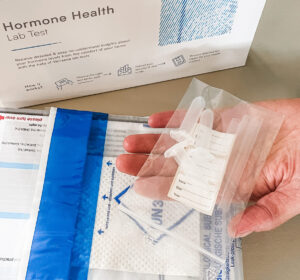
Blood test, saliva test or urine test?
Which test should I choose?
Blood test, saliva test and the so-called “Dutch test” are among the three most common test methods.
What are the possibilities of each of these tests and what are the advantages and disadvantages?

There are hundreds of hormones and in this case we specifically focus on testing 6 steroid hormones, namely; estradiol, estriol, progesterone, testosterone, DHEA and cortisol.
These hormones are classified as steroid hormones because they are lipophilic, meaning they are soluble in fat. This has implications for how they should be measured. Although a blood test is suitable for measuring water-soluble signaling substances such as peptides, it does not perform optimally when measuring fat-soluble hormones, as shown in the diagram.
Blood test
The research shows that blood tests are among the least accurate measurement methods. Fat-soluble hormones bind mainly to red blood cells – which is one reason why blood tests fail. Before the analysis, the red blood cells are removed. What remains is called serum. In this way, a large part of the hormones you want to measure have been removed in advance. A small portion is bound to proteins, and based on this limited portion one must then make a mathematical calculation of the total amount if one had not removed most of it. It is therefore not an actual measurement of the hormones and this makes the result less accurate.
Dutch Test
The Dutch test is a urine test that reveals which hormones the body secretes. Dutch stands for 'Dried Urine Test Comprehensive Hormones'. In the so-called Dutch+ variant, the urine sample is supplemented with a measurement of cortisol in saliva.
A urine test such as the Dutch test can be used to see in which forms estrogens are excreted, known as estrogen metabolites. This may be relevant in situations where it is suspected that estrogens are not converted properly.
But the test cannot measure the active hormones – the hormones that the body actually has. For example, if there are problems with the excretion of estradiol, it can be returned to the body via “reabsorption” instead of being excreted, resulting in higher levels of active estradiol than the measurement indicates.
Neither a blood test nor the Dutch test is suitable for checking the use of supplements in the correct dosages. Supplements in the form of creams or patches add hormones to the blood in the form of free hormones that are immediately available to the body. Research shows that levels of free, active hormones are not reflected in a blood test or a urine test such as the Dutch test.
Saliva test
Saliva samples have become increasingly popular with researchers due to their reliability and the fact that they are considered non-invasive, thus avoiding needle sticks. In studies that require measuring hormone levels, such as cortisol, in participants several times a day, the use of saliva samples offers significant advantages over blood samples.
A notable advantage of the saliva test is that, unlike blood and urine tests, it can measure active hormones that are immediately available to the body. Fat-soluble hormones effectively move from the blood to the saliva and maintain their active state. This allows the saliva test to measure with more precision what the body actually has available, even when supplements are administered via creams or patches, compared to both blood and urine tests.
Conclusion
Based on the above, 'NHT Naturlig Hormonterapi' has chosen the saliva sample as a measuring method. It is the only one of the three methods that can measure the hormones that are actually available to the body, and is cited by the researchers as the most reliable measurement method when it comes to steroid hormones. A state-recognized, ISO-certified German laboratory was chosen to analyze the test.
A saliva sample can, if relevant, be supplemented with a urine sample, the Estronex test, which measures estrogen metabolites. The Estronex test, like the saliva test, is performed at home and analyzed in the same ISO-certified laboratory. This way, as a client, you benefit from all the benefits that a saliva sample brings:
- Receiving a scientific, recognized sample.
- Measuring the actual availability of hormones in the body.
- Checking the correct dosage of any supplements based on the test results.
These benefits are only achieved using a saliva sample.
For more information on the reliability of saliva samples and how fat-soluble steroid hormones pass from the blood into the saliva, please visit the journal CLINICAL CHEMISTRYUlla Brouwer operates the website https://mijnbedrijven.eu (the “Service”).
Saliva samples are easy to collect and do not require needles or blood samples.
Citation NHT.dk
Scientific research:
Saliva test that spots hormone levels in pregnant women ‘could cut premature births’ | Daily Mail Online Low saliva progesterone concentrations are associated with spontaneous early preterm labour (before 34 weeks of gestation) in women at increased risk of preterm delivery – Lachelin – 2009 – BJOG: An International Journal of Obstetrics & Gynaecology – Wiley Online Library






